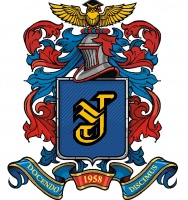Дальневосточный математический журнал
Лагранжева формулировка определяющих соотношений гиперупругого материала Генки |
С. Н. Коробейников, А. А. Олейников |
2011, выпуск 2, С. 155–180 |
Аннотация |
| Получено новое представление тензора упругости четвертого порядка для гиперупругого изотропного материала Генки. Компактность этого представления обусловлена использованием собственных проекций правого тензора деформаций Коши – Грина. Показано, что полученный тензор упругости обладает как минорными симметриями, так и главной симметрией. |
Ключевые слова: изотропная гиперупругость, материал Генки, тензор упругости, собственные проекции |
Полный текст статьи (файл PDF) |
Библиографический список |
| [1] L. Anand, “On Hencky's approximate strain-energy function for moderate deformations”, Trans. ASME, J. Appl. Mech., 46:1 (1979), 78–82. [2] L. Anand, “Moderate deformations in extension-torsion of incompressible isotropic elastic materials”, J. Mech. Phys. Solids., 34 (1986), 293–304. [3] Б. Д. Аннин, С. Н. Коробейников, “Обобщенные сопряженные тензоры напряжений и деформаций”, Сиб. журн. инд. мат., 7:3 (2004), 21–43. [4] J. Arghavani, F. Auricchio, R. Naghdabadi, “A finite strain kinematic hardening constitutive model based on Hencky strain: General framework, solution algorithm and application to shape memory alloys”, Int. J. Plasticity, 27 (2011), 940–961. [5] A. F. M. Arif, T. Pervez, M. P. Mughal, “Performance of a fnite element procedure for hyperelastic-viscoplastic large deformation problems”, Finite Elements in Analysis and Design, 34 (2000), 89–112. [6] M. Asghari, S. Naghdabadi, S. Sohrabpour, “Some basis-free expressions for stresses conjugate to Hill's strains through solving the tensor equation AX+XA=C”, Int. J. Solids Struct., 45 (2008), 3584–3595. [7] M. Asghari, “Basis free expressions for the stress rate of isotropic elastic materials in the cases of coalescent principal stretches”, Int. J. Solids Struct., 47 (2010), 611–613. [8] K.-J. Bathe, Finite Element Procedures, Prentice Hall, Upper Saddle River, N.J., 1996. [9] R. C. Batra, “Linear constitutive relations in isotropic finite elasticity”, J. Elast., 51 (1998), 243–245. [10] R. C. Batra, “Comparison of results from four linear constitutive relations in isotropic finite elasticity”, Int. J. Non-Linear Mech., 36 (2001), 421–432. [11] A. Bertram, Elasticity and Plasticity of Large Deformations. An Introduction, 2nd ed., Springer, Berlin, 2008. [12] J. Bonet, R. D. Wood, Nonlinear Continuum Mechanics for Finite Element Analysis, Cambridge Univ. Press, Cambridge, 1997. [13] O. T. Bruhns, A. Meyers, H. Xiao, “Hencky's elasticity model with the logarithmic strain measure: a study on Poynting effect and stress response in torsion of tubes and rods”, Arch. Mech., 52:4–5 (2000), 489–509. [14] O. T. Bruhns, A. Meyers, H. Xiao, “Finite Bending of a Rectangular Block of an Elastic Hencky Material”, J. Elast., 66 (2002), 237–256. [15] К. Ф. Черных, Нелинейная теория упругости в машиностроительных расчетах, Машиностроение, Л., 1986. [16] A. Chiskis, “Linear stress-strain relations in nonlinear elasticity”, Acta Mech., 146 (2001), 109–113. [17] J. C. Criscione, J. D. Humphrey, A. S. Douglas, W. C. Hunter, “An invariant basis for natural strain which yields orthogonal stress response terms in isotropic hyperelasticity”, J. Mech. Phys. Solids., 48 (2000), 2445–2465. [18] J. C. Criscione, “Direct tensor expression for natural strain and fast, accurate approximation”, Computers and Structures, 80 (2002), 1895–1905. [19] A. Curnier, L. Rakotomanana, “Generalized strain and stress measures: critical survey and new results”, Eng. Trans., 39:3–4 (1991), 461–538. [20] A. Curnier, Computational Methods in Solid Mechanics, Kluwer Academic Publ., Dordrecht, 1994. [21] A. Curnier, Ph. Zysset, “A family of metric strains and conjugate stresses, prolonging usual material laws from small to large transformations”, Int. J. Solids Structures, 43 (2006), 3057–3086. [22] H. Darijani, R. Naghdabadi, “Hyperelastic materials behavior modeling using consistent strain energy density functions”, Acta Mech., 213 (2010), 235–254. [23] H. Darijani, R. Naghdabadi, “Constitutive modeling of solids at finite deformation using a second-order stress-strain relation”, Int. J. Engng Sci., 48 (2010), 223–236. [24] J. Diani, P. Gilormini, “Combining the logarithmic strain and the full-network model for a better understanding of the hyperelastic behavior of rubber-like materials”, J. Mech. Phys. Solids., 53 (2005), 2579–2596. [25] P. Dluzewski, “Anisotropic hyperelasticity based upon general strain measures”, J. Elast., 60 (2000), 119–129. [26] G. Dui, “Time rates of Hill's strain tensors”, J. Elast., 54 (1999), 129–140. [27] G. Dui, Q. Ren, Z. Shen, “Conjugate stresses to Seth's strain class”, Mech. Res. Commun., 27:5 (2000), 539–542. [28] G. Dui, Y. Chen, “Basis-free representations for the stress rate of isotropic materials”, Int. J. Solids Struct., 41 (2004), 4845–4860. [29] G. Dui, “Some basis-free formulae for the time rate and conjugate stress of logarithmic strain tensor”, J. Elast., 83 (2006), 113–151. [30] G. Dui, Z. Wang, Q. Ren, “Explicit formulations of tangent stiffness tensors for isotropic materials”, Int. J. Numer. Meth. Engng., 69 (2007), 665–675. [31] K. Farahani, R. Naghdabadi, “Conjugate stresses of the Seth-Hill strain tensors”, Int. J. Solids Struct., 37 (2000), 5247–5255. [32] K. Farahani, R. Naghdabadi, “Basis free relations for the conjugate stresses of the strains based on the right stretch tensor”, Int. J. Solids Struct., 40 (2003), 5887–5900. [33] K. Farahani, H. Bahai, “Hyper-elastic constitutive equations of conjugate stresses and strain tensors for the Seth-Hill strain measures”, Int. J. Engng Sci., 42 (2004), 29–41. [34] J. E. Fitzgerald, “A tensorial Hencky measure of strain and strain rate for finite deformations”, J. Appl. Phys., 51:10 (1980), 5111–5115. [35] Y. C. Fung, Foundations of Solid Mechanics, Prentice-Hall, Englewood Cliffs, N.J., 1965. [36] G. Gabriel, K. J. Bathe, “Some computational issues in large strain elasto-plastic analysis”, Computers and Structures, 56:2/3 (1995), 249–267. [37] M. G. D. Geers, “Finite strain logarithmic hyperelasto-plasticity with softening: a strongly non-local implicit gradient framework”, Comput. Methods Appl. Mech. Eng., 193 (2004), 3377–3401. [38] K. Ghavam, R. Naghdabadi, “Hardening materials modeling in finite elastic-plastic deformations based on the stretch tensor decomposition”, Materials & Design, 29 (2008), 161–172. [39] А. И. Голованов, “Конечно-элементное моделирование больших деформаций гиперупругих тел в терминах главных удлинений”, Вычислительная механика сплошных сред, 2:1 (2009), 19–37. [40] А. И. Голованов, “Численное моделирование больших деформаций упругопластических тел в терминах логарифмов главных удлинений”, Вычислительная механика сплошных сред, 4:1 (2011), 25–35. [41] K. Hashiguchi, Elastoplasticity Theory, Springer, Berlin, 2009. [42] P. Haupt, Ch. Tsakmakis, “Stress tensors associated with deformation tensors via duality”, Arch. Mech., 48:2 (1996), 347–384. [43] K. Heiduschke, “The logarithm strain space description”, Int. J. Solids Struct., 32 (1995), 1047–1062. [44] R. Hill, “On constitutive inequalities for simple materials — I”, J. Mech. Phys. Solids., 16:4 (1968), 229–242. [45] R. Hill, “Aspects of invariance in solid mechanics”, Advances in Applied Mechanics, 18, Academic Press, New York, 1–75. [46] G. A. Holzapfel, Nonlinear Solid Mechanics: A Continuum Approach for Egineering, Wiley, Chichester et al., 2000. [47] C. O. Horgan, J. G. Murphy, “A generalization of Hencky's strain-energy density to model the large deformations of slightly compressible solid rubbers”, Mechanics of Materials, 41 (2009), 943–950. [48] M. Itskov, “On the theory of fourth-order tensors and their applications in computational mechanics”, Comput. Methods Appl. Mech. Eng., 189 (2000), 419–438. [49] M. Itskov, Tensor Algebra and Tensor Analysis for Engineers (with Applications to Continuum Mechanics), Springer, Berlin, 2007. [50] C. S. Jog, “The explicit determination of the logarithm of a tensor and its derivatives”, J. Elast., 93 (2008), 141–148. [51] P. A. Kakavas, “A new development of the strain energy function for hyperelastic materials using a logarithmic strain approach”, Journal of Applied Polymer Science, 77 (2000), 660–672. [52] O. Kintzel, Y. Basar, “Fourth-order tensors - tensor differentiation with applications to continuum mechanics. P. I: Classical tensor analysis”, ZAMM, 86:4 (2006), 291–311. [53] S. N. Korobeinikov, V. P. Agapov, M. I. Bondarenko, A. N. Soldatkin, “The general purpose nonlinear finite element structural analysis program PIONER”, Int. Conf. on Numerical Methods and Applications, Sofia, 1989, 228–233. [54] С. Н. Коробейников, Нелинейное деформирование твердых тел, Из-во СО РАН, Новосибирск, 2000. [55] С. Н. Коробейников, “Строго сопряженные тензоры напряжений и деформаций”, ПМТФ, 41:3 (2000), 513–518. [56] S. N. Korobeynikov, “Objective tensor rates and applications in formulation of hyperelastic relations”, J. Elast., 93 (2008), 105–140. [57] S. N. Korobeynikov, “Families of continuous spin tensors and applications in continuum mechanics”, Acta Mech., 216:1–4 (2011), 301–332. [58] I-Sh. Liu, “On the transformation property of the deformation gradient under a change of frame”, J. Elast., 71 (2003), 73–80. [59] C. P. Luehr, M. B. Rubin, “The significance of projection operators in the spectral representatin of symmetric second order tensors”, Comput. Methods Appl. Mech. Eng., 84 (1990), 243–246. [60] А. И. Лурье, Нелинейная теория упругости, Наука, М., 1980. [61] C.-S. Man, Z.-H. Guo, “A basis-free formula for time rate of Hill's strain tensor”, Int. J. Solids Struct., 30:20 (1993), 2819–2842. [62] MARC Users Guide, v. A, Theory and Users Information, MSC. Software Corporation, Santa Ana (CA), 2010. [63] J. E. Marsden, T. J. R. Hughes, Mathematical Foundations of Elasticity, Prentice-Hall, Englewood Cliffs, N.J., 1983. [64] A. Meyers, H. Xiao, O. T. Bruhns, “Choice of objective rate in single parameter hypoelastic deformation cycles”, Computers and Structures, 84 (2006), 1134–1140. [65] C. Miehe, “Aspects of the formulation and finite element implementation of large strain isotropic elasticity”, Int. J. Numer. Meth. Engng., 37 (1994), 1981–2004. [66] C. Miehe, “Comparison of two algorithms for the computation of fourth-order isotropic tensor functions”, Computers and Structures, 66:1 (1998), 37–43. [67] C. Miehe, M. Lambrecht, “Algorithms for computation of stresses and elasticity moduli in terms of Seth–Hill’s family of generalized strain tensors”, Comm. Numer. Meth. Engng., 17 (2001), 337–353. [68] C. Miehe, “Anisotropic additive plasticity in the logarithmic strain space: modular kinematic formulation and implementation based on incremental minimization principles for standard materials”, Comput. Methods Appl. Mech. Engrg., 191 (2002), 5383–-5425. [69] C. Miehe, S. Go?ktepe, J. M. Diez, “Finite viscoplasticity of amorphous glassy polymers in the logarithmic strain space”, Int. J. Solids Structures, 46 (2009), 181–-202. [70] C. Miehe, J. M. Diez, S. Go?ktepe, L.-M. Scha?nzel, “Coupled thermoviscoplasticity of glassy polymers in the logarithmic strain space based on the free volume theory”, Int. J. Solids Structures, 48 (2011), 1799–-1817. [71] K. N. Morman, Jr., “The generalized strain measure with application to nonhomogeneous deformations in rubber-like solids”, Trans. ASME, J. Appl. Mech., 53 (1986), 726–728. [72] F. D. Murnaghan, Finite Deformation of an Elastic Solid, Wiley, New York, 1951. [73] J. J. Nader, “Linear response in finite elasticity”, J. Elast., 73 (2003), 165–172. [74] R. Naghdabadi, M. Yeganeh, A. R. Saidi, “Application of corotational rates of the logarithmic strain in constitutive modeling of hardening materials at finite deformations”, Int. J. Plasticity, 21 (2005), 1546–1567. [75] D. W. Nicholson, “Tangent modulus matrix for finite element analysis of hyperelastic materials”, Acta Mech., 112 (1995), 187–201. [76] В. В. Новожилов, “О принципах обработки результатов статических испытаний изотропных материалов”, ПММ, 15:6 (1951), 709–722. [77] В. В. Новожилов, Теория упругости, Судпромгиз, Л., 1958. [78] R. W. Ogden, Non-linear Elastic Deformations, Ellis Horwood, Chichester, 1984. [79] F. Peyraut, Z.-Q. Feng, Q.-C. He, N. Labed, “Robust numerical analysis of homogeneous and non-homogeneous deformations”, Appl. Num. Math., 59 (2009), 1499–1514. [80] G. Piero, “Some properties of the set of fourth-order tensors, with application to elasticity”, J. Elast., 9:3 (1979), 245–261. [81] J. Plesek, A. Kruisova, “Formulation, validation and numerical procedures for Hencky's elasticity model”, Computers and Structures, 84 (2006), 1141–1150. [82] А. А. Поздеев, П. В. Трусов, Ю. И. Няшин, Большие упругопластические деформации, Наука, М., 1986. [83] W. Prager, Einfu?hrung in die Kontinuumsmechanik, Birkha?user Verlag, Basel, 1961; русс. пер.: В. Прагер, Введение в механику сплошных сред, Изд-во иностр. лит., М., 1963. [84] C. Sansour, “On the dual variable of the logarithmic strain tensor, the dual variable of the Cauchy stress tensor, and related issues”, Int. J. Solids Struct., 38 (2001), 9221–9232. [85] M. Scheidler, “Time rates of generalized strain tensors. Part I: Component formulas”, Mechanics of Materials, 11 (1991), 199–210. [86] A. V. Shutov, R. Krei?ig, “Application of a coordinate-free tensor formalism to the numerical implementation of a material model”, ZAMM, 88:11 (2008), 888–909. [87] J. C. Simo, T. J. R. Hughes, Computational Inelasticity, Springer, Berlin, 1998. [88] C. Truesdell, W. Noll, The Non-linear Field Theories of Mechanics, v. III/3, Handbuch der Physik, ed. S. Flu?gge, Springer, New York, 1965. [89] П. В. Трусов, О. И. Дударь, И. А. Келлер, Тензорная алгебра и анализ, Пермский ТУ, Пермь, 1998. [90] K. Y. Volokh, “Comments and authors' reply on “Linear stress-strain relations in nonlinearelasticity” by A. Chiskis and R. Parnes (Acta Mech. 146, 109–113, 2001)”, Acta Mech., 171 (2004), 241–245. [91] G. Weber, L. Anand, “Finite deformation constitutive equations and a time integration procedure for isotropic, hyperelastic-viscoplastic solids”, Comput. Methods Appl. Mech. Eng., 79 (1990), 173–202. [92] H. Xiao, “Unified explicit basis-free expressions for time rate and conjugate stress of an arbitrary Hill's strain”, Int. J. Solids Struct., 32:22 (1995), 3327–3340. [93] H. Xiao, O. T. Bruhns, A. Meyers, “Logarithmic strain, logarithmic spin and logarithmic rate”, Acta Mech., 124 (1997), 89–105. [94] H. Xiao, O. T. Bruhns, A. Meyers, “Hypo-elasticity model based upon the logarithmic stress rate”, J. Elast., 47 (1997), 51–68. [95] H. Xiao, O. T. Bruhns, A. Meyers, “Strain rates and material spins”, J. Elast., 52 (1998), 1–41. [96] H. Xiao, O. T. Bruhns, A. Meyers, “Objective corotational rates and unified work-conjugacy relation between Eulerian and Lagrangean strain and stress measures”, Arch. Mech., 50:6 (1998), 1015–1045. [97] H. Xiao, O. T. Bruhns, A. Meyers, “Direct relationship between the Lagrangean logarithmic strain and the Lagrangean stretching and the Lagrangean Kirchhoff stress”, Mechanics Research Communications, 25:1 (1998), 59–67. [98] H. Xiao, O. T. Bruhns, A. Meyers, “Existence and uniqueness of the integrable-exactly hypoelastic equation $\r\tau^*=\lambda(\tr D)I+2\mu D$ and its significance to finite inelasticity”, Acta Mech., 138 (1999), 31–50. [99] H. Xiao, O. T. Bruhns, A. Meyers, “A natural generalization of hypoelasticity and Eulerian rate type formulation of hyperelasticity”, J. Elast., 56 (1999), 59–93. [100] H. Xiao, O. T. Bruhns, A. Meyers, “The choice of objective rates in finite elastoplasticity: general results on the uniqueness of the logarithmic rate”, Proc. R. Soc. Lond. A., 456 (2000), 1865–1882. [101] H. Xiao, O. T. Bruhns, A. Meyers, “Basis issues concerning finite strain measures and isotropic stress-deformation relations”, J. Elast., 67 (2002), 1–23. [102] H. Xiao, L. S. Chen, “Hencky's elasticity model and linear stress-strain relations in isotropic finite hyperelasticity”, Acta Mech., 157 (2002), 51–60. [103] H. Xiao, L. S. Chen, “Hencky's logarithmic strain and dual stress-strain and strain-stress relations in isotropic finite hyperelasticity”, Int. J. Solids Struct., 40 (2003), 1455–1463. [104] H. Xiao, O. T. Bruhns, A. Meyers, “Explicit dual stress-strain and strain-stress relations of incompressible isotropic hyperelastic solids via deviatoric Hencky |






